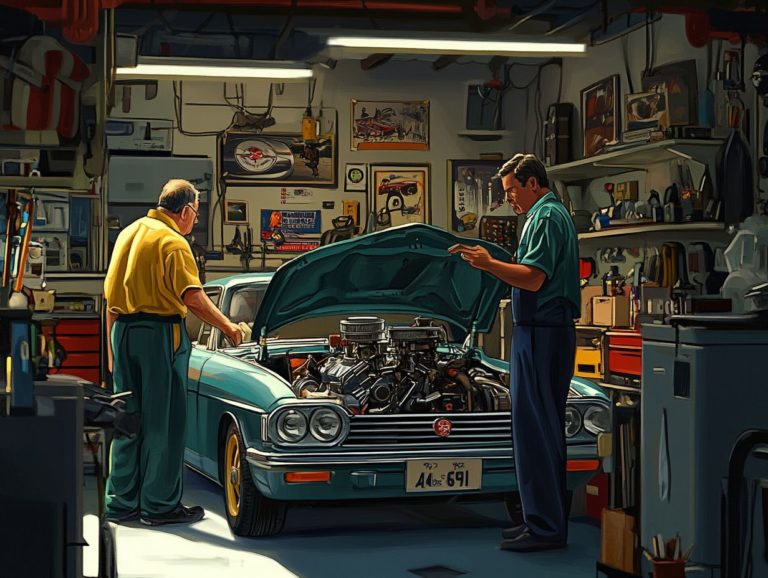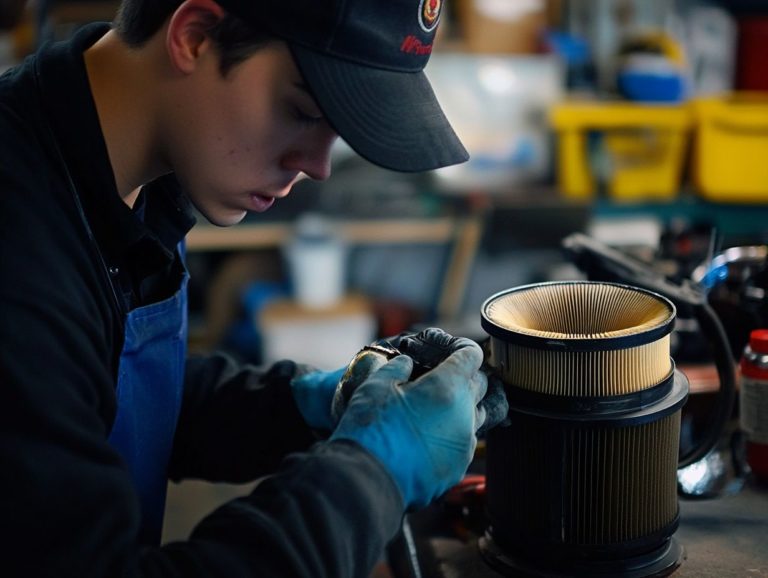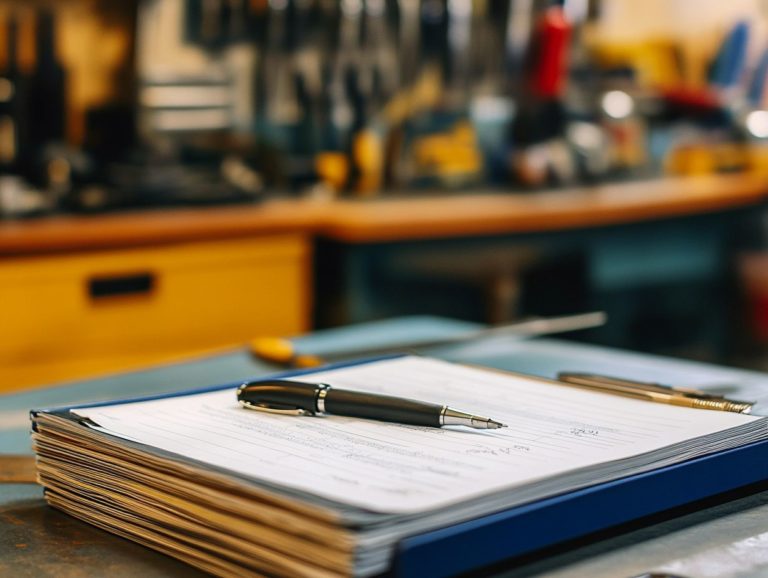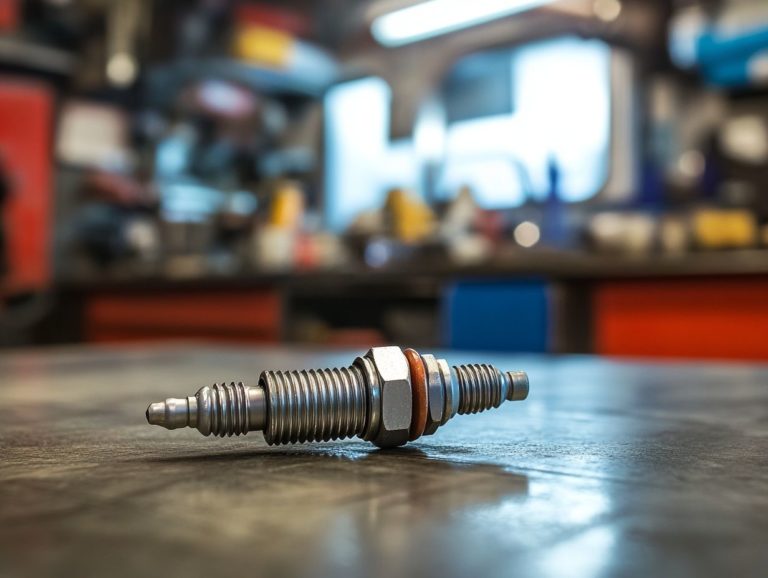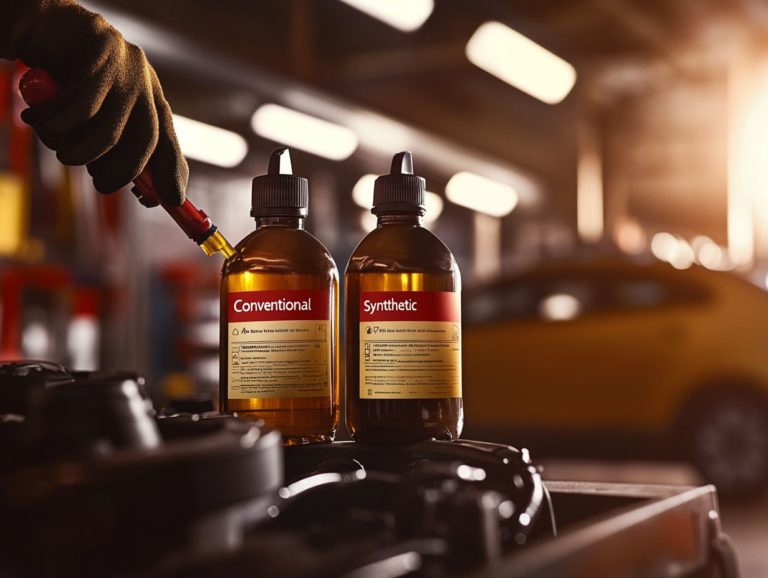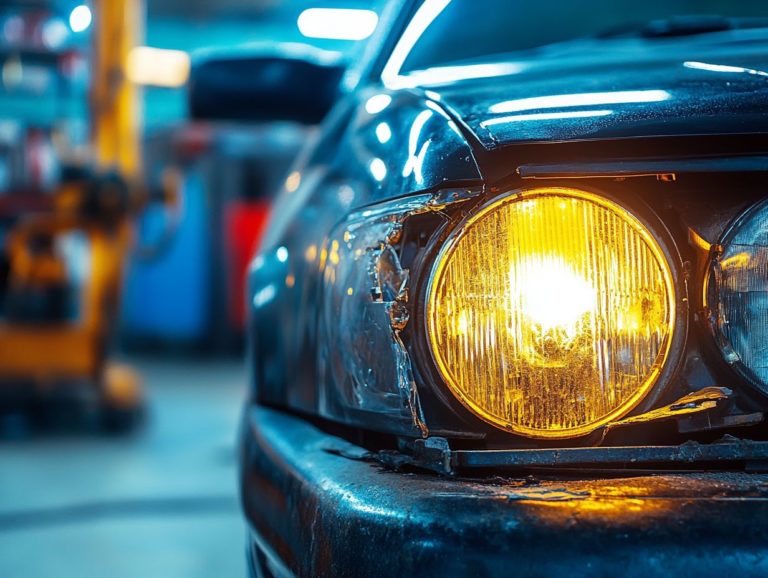7 Tips for DIY Brake Maintenance
Maintaining your vehicle s brakes is crucial for both safety and performance, yet it can often feel overwhelming. This guide offers seven practical tips for DIY brake maintenance that empower you to take charge of your car’s upkeep.
From assembling the right tools to recognizing when it s time to bring in a professional, you ll find everything you need to ensure your brakes remain in optimal condition. Discover the common signs of wear, how often to perform maintenance, and the essential safety precautions to keep in mind.
Dive in and build your confidence in your brake maintenance skills!
Contents
- Key Takeaways:
- 1. Gather the Necessary Tools and Materials
- 2. Find a Safe and Level Area to Work On
- 3. Remove the Wheel and Inspect the Brakes
- 4. Clean and Replace Any Worn or Damaged Parts
- 5. Reassemble and Test the Brakes
- 6. Bleed the Brake System if Necessary
- 7. Properly Dispose of Old Brake Parts and Fluid
- When Should You Seek Professional Help?
- What Are the Common Signs of Brake Wear and Tear?
- How Often Should You Check and Maintain Your Brakes?
- What Are the Benefits of Regular DIY Brake Maintenance?
- What Are the Safety Precautions to Take When Working on Brakes?
- How Can You Tell If Your Brakes Need to Be Replaced?
- What Are Some Common Mistakes to Avoid When Doing DIY Brake Maintenance?
- Frequently Asked Questions
- What are the 7 tips for DIY brake maintenance?
- Why is it important to inspect brake pads and rotors regularly?
- How often should brake fluid be checked?
- When should brake pads and rotors be replaced?
- What is the proper way to clean and lubricate caliper slides?
- Why is it necessary to flush brake fluid?
- How can I test my brakes after performing DIY maintenance?
Key Takeaways:
- Always gather all necessary tools and materials before beginning DIY brake maintenance to avoid delays or incomplete repairs.
- Choose a safe and flat surface to work on to ensure stability and prevent accidents while working on your brakes.
- Keep your brakes in top shape with regular checks; it s your key to safe driving!
1. Gather the Necessary Tools and Materials
Before you dive into changing your brake pads, it’s vital to gather all necessary tools and materials. This preparation will ensure a smooth and safe DIY brake replacement process.
Equip your garage with a dependable lug wrench, a sturdy jack, a C-clamp to compress the brake components, and some brake cleaner. These essentials set you up for success.
Choose the right brake pads, as they significantly influence your vehicle’s efficiency and safety. Also, have brake grease and fluid ready; they are essential for perfecting the installation.
This preparation streamlines the process, instills confidence, and helps you avoid potential issues down the road.
2. Find a Safe and Level Area to Work On
Finding a safe and level area to work on your vehicle is essential for both safety and efficiency during your brake maintenance tasks.
Choosing the right spot shields you from potential accidents and facilitates proper tire removal and installation. Use jack stands correctly, as they provide the necessary support to keep your vehicle stable.
Always verify that the ground is even; this minimizes the risk of your vehicle shifting unexpectedly. A well-prepared workspace promotes an effective workflow, allowing a smoother process.
3. Remove the Wheel and Inspect the Brakes
The journey of vehicle maintenance starts with the meticulous removal of the wheel, granting you access to inspect the brake pads and other components for any signs of wear or damage.
Safely lift your vehicle with a jack and secure it on jack stands. Once the wheel is off, closely examine the brake pads. Uneven wear can present itself as a tapering effect or significant grooves; recognizing these issues early is vital for maintaining optimal braking efficiency.
Inspect the calipers and rotors carefully; rust or scoring can signal deeper issues. Regular maintenance extends the lifespan of your braking system and ensures your vehicle remains safe on the road.
4. Clean and Replace Any Worn or Damaged Parts
Cleaning and replacing any worn or damaged parts is crucial for maintaining optimal brake performance. When you install new brake pads, do so in a clean environment, free from brake dust and debris.
Use brake cleaner effectively to ensure thorough cleaning of the components. Apply the cleaner in a well-ventilated area, allowing ample time for any residual solvent to evaporate completely before installation.
Don t forget to lubricate the brake pads, especially the backing side and contact points. This step reduces friction and prevents annoying squeaking that can lead to premature wear.
Also, replace any worn or corroded retaining clips; they play a vital role in securing the pads and preventing movement that could cause noise or malfunctions during braking. Ensuring that all parts are in good condition is essential for safe, reliable performance.
Don t wait until it s too late; check your brakes regularly! Schedule your brake check today to ensure your vehicle is safe on the road.
5. Reassemble and Test the Brakes
After cleaning and replacing worn components, reassembling the brake assembly correctly is crucial. It ensures the safe and effective operation of your braking system.
This process typically begins with securely reattaching the caliper bolts. It’s essential to tighten them to the manufacturer s specifications to prevent any potential issues during operation.
If your vehicle’s brake system requires a service mode, make sure to follow the specific steps to engage this feature before installation.
Once everything is in place, take a moment to double-check all connections and ensure the components are properly seated. After reassembly, testing the brakes is a critical step to verify their performance and reliability. This helps catch any irregularities before you hit the road, which is paramount for maintaining safety.
6. Bleed the Brake System if Necessary
Bleeding the brake system is an essential task. It ensures any air trapped within the brake lines is effectively removed, enhancing brake fluid performance and your overall safety.
Proper brake functionality hinges on the way brake fluid works, making it paramount to check the fluid levels before diving into this process.
- Start by inspecting the master cylinder reservoir to confirm it s filled to the appropriate level.
- Low fluid levels can be a red flag, suggesting potential leaks or worn components that need attention.
- If the brake light indicator on your dashboard lights up, consider it a warning sign. It means the brake fluid might need a top-up or that a bleeding procedure is in order, prompting a more thorough inspection of your brake system’s integrity.
7. Properly Dispose of Old Brake Parts and Fluid
Proper disposal of old brake parts and fluid is essential for both environmental safety and compliance with local regulations. It ensures that hazardous materials are managed appropriately.
Many automotive chemicals pose serious risks to the environment if not disposed of properly. It’s crucial to familiarize yourself with local guidelines regarding hazardous waste disposal.
Improper handling can lead to significant soil and water contamination, which is something no one wants.
Your community likely offers recycling programs for brake parts and other automotive components. By taking advantage of these resources, you can actively help reduce pollution and promote sustainability.
Always look for local facilities that accept automotive waste. Make sure these materials are recycled whenever possible your environment will thank you!
When Should You Seek Professional Help?
While taking on a DIY brake replacement can be a fulfilling project, there are key moments when reaching out to brake professionals at an auto repair shop becomes crucial for your safety and the effectiveness of the repair.
For instance, if you find yourself facing complex brake issues like a persistent grinding noise or an ominous warning light on your dashboard it’s essential to consult with experts who can conduct a thorough diagnosis.
When you lack the necessary experience or tools, whether it’s specialized equipment for hydraulic systems or high-quality replacement parts, turning to professionals ensures that every repair meets industry standards.
Their expertise not only offers you peace of mind but also significantly enhances your vehicle s safety. Keep in mind that regular professional brake maintenance can prevent minor problems from snowballing into serious safety hazards.
Investing in this service is a smart choice for any car owner who values both safety and performance.
What Are the Common Signs of Brake Wear and Tear?
Common signs of brake wear and tear like unusual noises and uneven wear patterns should prompt you to seek immediate attention to ensure your brakes perform at their best.
Be vigilant for grinding sensations when you apply the brakes. This often signals that your brake pads have worn down excessively and may lead to further damage. If you notice reduced braking efficiency where your vehicle takes longer to stop than usual this is another critical signal that your brakes require inspection.
To stay ahead of potential issues, it s wise to check your brake components regularly. Examine the thickness of the pads and look for visible cracks on the rotors. Keeping an ear out for squeaking or whining noises during operation can help you catch problems early before they escalate.
How Often Should You Check and Maintain Your Brakes?
Regularly checking and maintaining your brakes is crucial for safe driving. You’ll find tailored recommendations in your vehicle owner’s manual that align with your unique driving habits.
Consider factors like the type of terrain you navigate, your driving speed, and overall mileage. These all play significant roles in determining when your brakes should be inspected. If you often tackle hilly landscapes or find yourself in heavy traffic, check your brakes more frequently due to the additional wear.
Be ready to adjust your maintenance schedule if your vehicle endures heavy use. By adapting these guidelines, you ensure that your braking system remains effective, keeping both you and your passengers safe on the road.
What Are the Benefits of Regular DIY Brake Maintenance?
Engaging in regular DIY brake maintenance boosts your brake performance and leads to significant cost savings. You also gain a deeper understanding of your vehicle’s brake system.
By taking the time to perform these checks and adjustments, you empower yourself to identify potential issues before they escalate. This ultimately prioritizes safety on the road. Eliminating labor costs associated with auto shops allows you to redirect your finances toward essential maintenance or upgrades.
Gaining hands-on experience fosters a greater appreciation for automotive mechanics. This equips you with skills that enhance your overall expertise. Your growing knowledge builds confidence and enables you to make informed decisions in future vehicle-related endeavors, reinforcing your commitment to automotive excellence.
What Are the Safety Precautions to Take When Working on Brakes?
Taking the right safety precautions is essential when working on brakes. Improper handling of tools and materials can lead to serious accidents or damage to the brake system.
To ensure a safe environment, make it a habit to wear protective gear like gloves and goggles. These can shield you from sharp tools and hazardous substances. Proper usage of tools is crucial in preventing mishaps, so familiarize yourself with the equipment before starting. If you’re lifting a vehicle for maintenance, securing it with jack stands is vital to avoid unexpected falls.
Exercise caution when handling brake fluid and other automotive chemicals, as they can be corrosive or harmful. By understanding these measures, you create a safer workspace and pave the way for a smoother repair process.
How Can You Tell If Your Brakes Need to Be Replaced?
Recognizing when your brakes need replacement is crucial for your vehicle’s safety. Look out for indicators such as brake light warnings and a noticeable decline in brake performance; these are critical signals that shouldn t be overlooked!
Be vigilant about visual cues indicating wear and tear, like worn brake pads or grooves on the rotors. Also, listen for persistent squeaking or grinding noises when braking these sounds reveal underlying issues that require your attention.
Regular inspections are more than just a habit; they re your best defense against potential problems. They ensure that your braking system operates effectively, safeguarding both you and your passengers. Stay alert to these signs and take proactive measures to maintain your brakes, preventing minor issues from becoming significant safety hazards.
What Are Some Common Mistakes to Avoid When Doing DIY Brake Maintenance?
When you start DIY brake maintenance, it’s vital to avoid common mistakes and learn how to prevent common brake repairs to ensure your safety and the effectiveness of the brake system.
One frequent misstep is overlooking the brake fluid levels, which can lead to weaker brakes or even a complete system failure. Another common blunder is neglecting to lubricate the brake pads properly, resulting in annoying squeaks and uneven wear.
To avoid these costly errors, inspect the brake fluid reservoir and top it off with the correct type of fluid as needed. Using the right lubricant during installation and applying it evenly on the brake pads can significantly improve their longevity and efficiency.
By taking these proactive measures, you can maintain a safe and reliable braking system.
Frequently Asked Questions
What are the 7 tips for DIY brake maintenance?
The 7 tips for DIY brake maintenance are: inspecting brake pads and rotors, checking brake fluid level, replacing brake pads and rotors if necessary, cleaning and lubricating caliper slides (the part that holds the brake pads), flushing brake fluid, bleeding brake lines, and testing brakes after maintenance.
Why is it important to inspect brake pads and rotors regularly?
Regularly inspecting brake pads and rotors is crucial because it helps catch any wear or damage early on, preventing potential brake failure or costly repairs.
How often should brake fluid be checked?
Check the brake fluid at least every 6 months or whenever you have your tires rotated. It s also a good idea to check before long drives or after driving in harsh conditions.
When should brake pads and rotors be replaced?
Replace brake pads and rotors when they are worn down to their minimum thickness or if they show signs of damage, such as cracks or warping. It s important to replace them promptly to ensure safe braking.
What is the proper way to clean and lubricate caliper slides?
The proper way to clean and lubricate caliper slides is to remove the caliper, clean the slides with brake cleaner, apply a thin layer of high-temperature brake lubricant, and reassemble the caliper. This ensures the brake pads move smoothly and evenly.
Why is it necessary to flush brake fluid?
Flushing brake fluid removes contaminants or moisture that can affect your brakes’ performance. This helps maintain the proper viscosity and boiling point of the brake fluid, ensuring efficient braking.
How can I test my brakes after performing DIY maintenance?
Test your brakes by taking your vehicle for a test drive and gradually applying the brakes. Listen for any unusual noises or vibrations and note how quickly the vehicle comes to a stop. If you notice any issues, it may be necessary to inspect or adjust your brake maintenance further.
Don t wait! Share your DIY experiences or ask questions about brake maintenance below.

